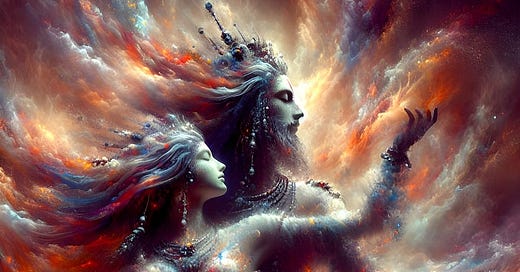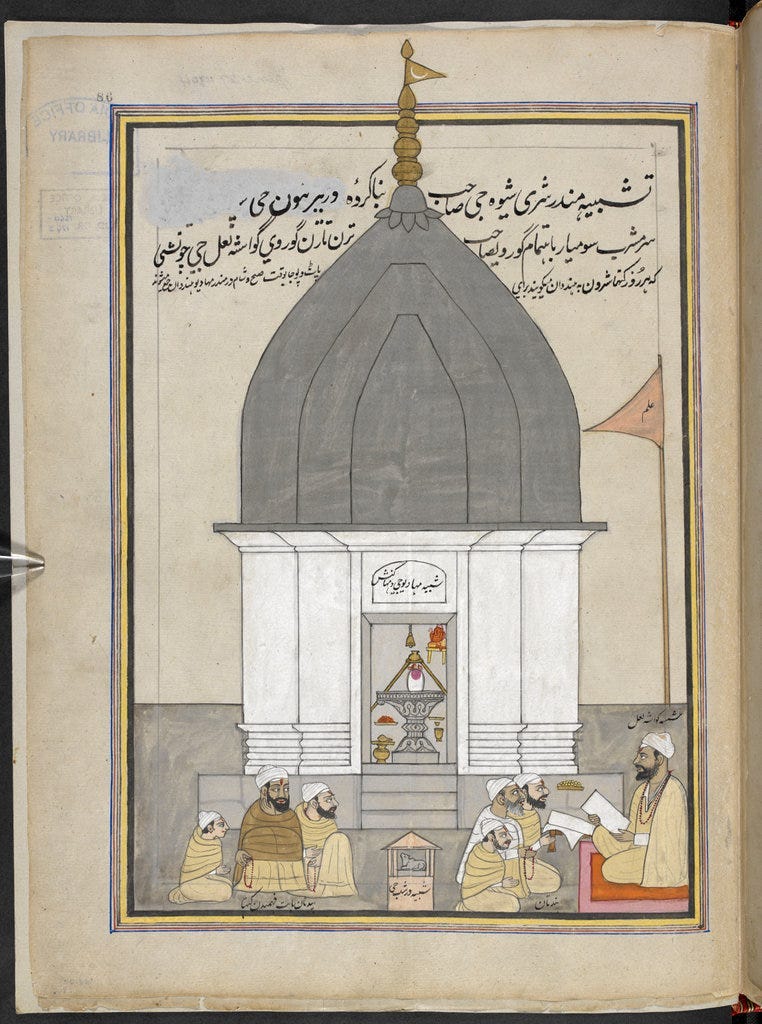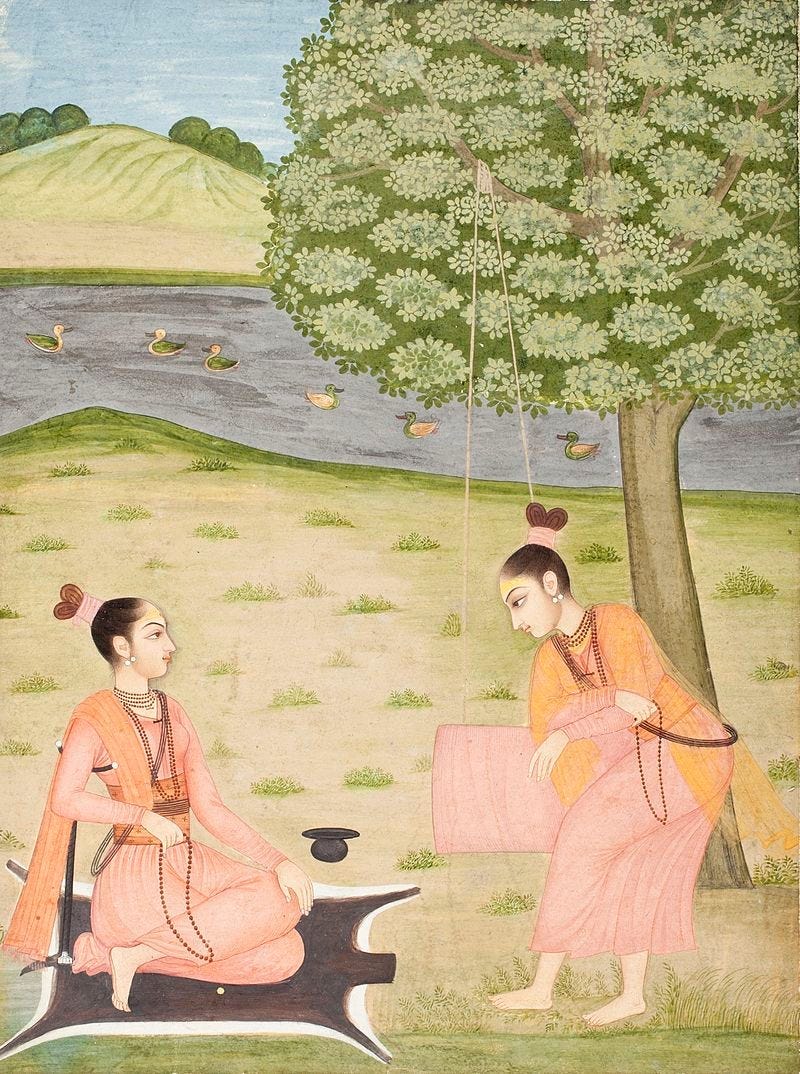Kashmir Shaivism: Bliss, Consciousness and the Tantric Way to Liberation
Fluctuating in the many analogies with Advaita Vedanta
Shiva and Shakti Dance — Image by Author
In the wild and remote lands of Kashmir, India, where snow-capped peaks are reflected in crystalline lakes, a unique and fascinating philosophical tradition blossoms: Kashmir Shaivism.
Far from the clamour of the modern world, this school of thought preserves an ancient wisdom that unfolds like a rare flower, blooming only for those who are willing to undertake an inner journey of discovery.
It is not easy to define Kashmir Shaivism: its teachings wind along tortuous paths, interweaving philosophy, spirituality and Tantric practices in a single, harmonious dance.
Perhaps it is this elusive nature that makes Kashmir Shaivism so irresistible: a veil of mystery envelops its secrets, teasing our imagination and inviting us to explore new territories of knowledge.
A neglected heritage
Unfortunately, Kashmir Shaivism is little known today in its homeland. Because of the conflict in Kashmir, many Kashmiri Pandits, traditionally custodians of this age-old tradition, have had to leave the region. Furthermore, there is a lack of qualified institutions and teachers to transmit knowledge authentically and rigorously.
However, the hope for an awakening is alive and thriving:
Institutions such as the Kashmir Shaivism Institute and the Shri Pratap Singh Museum are working tirelessly to preserve and promote this precious tradition, organizing seminars, conferences and study courses.
World-renowned scholars such as Laxman Joo, Jaideva Singh and Mark Dyczkowski have helped revive interest in Kashmir Shaivism, publishing books, and articles and translating classic texts into languages accessible to a wider audience.
Painting of a priest and worshippers at a Shiva temple in Srinagar, Kashmir, circa 1850–1860 — Wikipedia Free Image — https://upload.wikimedia.org/wikipedia/commons/9/9d/Painting_of_a_priest_and_worshippers_at_a_Shiva_temple_in_Srinagar%2C_Kashmir%2C_circa_1850%E2%80%931860.jpg
Like a hidden gem among the snowy mountains, Kashmir Shaivism awaits being rediscovered. Its precious gems — profound philosophy, Tantric spirituality and holistic worldview — can illuminate our path and enrich our understanding of reality.
At the throbbing heart of this tradition lies the doctrine of non-duality (Advaita). Like Advaita Vedanta, Kashmir Shaivism recognizes Brahman as the sole ontological reality. Yet, like two sinuous dancers, they express this truth in different ways.
Dates of birth of Kashmir Shaivism and Advaita Vedanta
The origins of Kashmir Shaivism are lost in the mists of time, with some traces dating back to as early as the 6th century BC. However, its official flowering is generally placed between the 8th and 9th centuries AD, with key figures such as Vasugupta, Somananda and Abhinavagupta.
Advaita Vedanta, as conceived by Adi Shankara, developed between the 8th and 9th centuries AD. Shankara, considered one of the greatest Indian philosophers, gave new impetus to this school of thought, reinterpreting Vedic texts, written between 1500 and 500 BCE, and systematizing the doctrine of non-duality.
Insights
Kashmir Shaivism and Advaita Vedanta
Similarities:
* Both systems recognize knowledge (Jnana) as the basis for liberation, attained through reflection, meditation and the study of sacred texts and philosophical works of great Hindu thinkers.
* Both aim at the realization of an ultimate reality, called Brahman in Advaita Vedanta and Shiva in Kashmir Shaivism.
* Both systems offer different paths to liberation, with specific approaches and practices.
Differences:
Advaita Vedanta:
* Upholds that Brahman is the only existing reality, while the phenomenal world is illusory (avidya).
*Brahman has no attributes, qualities or aspects, and is identical to Atman, the individual Self.
* The path of liberation relies on **study of sacred texts, meditation and grace of the guru**.
* Does not give much importance to the worship of Shiva or other deities.
Read My Novella: Shankara's Bhaja Govindam - Chronicle of an Abduction in Varanasi.
When I first read about the life and teachings of Adi Shankara, I was struck by how much spiritual wisdom and insight this 8th-century philosopher possessed. Shankara revived and reinterpreted the ancient philosophy of Advaita Vedanta, teaching radical ideas of non-duality and the illusion of separateness. His verses known as the Bhaja Govindam inspire …
Kashmir Shaivism:
* Affirms that Brahman is Shiva, whose generative power derives from the energy of Shakti, his consort.
* Shiva and Shakti are inseparable and constitute a dynamic and creative reality.
* Recognizes the multiplicity and diversity of the world as manifestations of Shiva.
* The path of liberation includes activating the inner Shakti through tantric practices involving body, mind and spirit.
* Gives great importance to the worship of Shiva and his various forms, intuition and direct experience.
Shiva and Parvati (which is associated with Shakti), Kashmir, 10 or 11th century — Wikipedia Free Image — https://upload.wikimedia.org/wikipedia/commons/thumb/9/95/Kashmir%2C_stele_con_shiva_e_parvati%2C_x-xi_secolo.jpg/800px-Kashmir%2C_stele_con_shiva_e_parvati%2C_x-xi_secolo.jpg
Shakti
Shakti is seen as the very essence of reality. The universe is conceived as a play of energies, a dance between Shiva (pure consciousness) and Shakti (creative energy). The male-female duality is seen as a manifestation of this divine dance, with Shakti representing the dynamic and creative aspect and Shiva the static and receptive aspect.
The tantric practices revolve around the activation and union with Kundalini Shakti, the dormant energy situated at the base of the spine.
The use of mantras, yantras, and mandalas, together with advanced meditation techniques like Kundalini yoga, makes it possible to awaken the inner Shakti and merge with the divine Consciousness.
An interesting analogy for understanding the difference between the two schools is that of fire. Advaita Vedanta focuses on the immutable nature of fire and its eternal essence. Kashmir Shaivism, on the other hand, focuses on the flame, the dynamic dance of fire that manifests in the world.
Two female Shaiva ascetics (18th-century painting) — WIkiCommons Free Image — https://upload.wikimedia.org/wikipedia/commons/thumb/c/c9/Female_Ascetics_%28Yoginis%29_LACMA_M.2011.156.4_%281_of_2%29.jpg/800px-Female_Ascetics_%28Yoginis%29_LACMA_M.2011.156.4_%281_of_2%29.jpg
Tantrism in Kashmir Shaivism: a concise and detailed definition
Tantrism is a holistic philosophy and practice that aims at union with the Supreme Consciousness through the integration of body, mind and spirit.
Tantrism focuses on the direct experience of divine reality, rather than on mere philosophical speculation.
What does Tantrism consist of in Kashmir Shaivism?
Kundalini life energy
* What is it? The dormant divine energy at the base of the spine.
* How is it awakened? Through meditation, yoga, Tantric sex and other specific practices.
* What are its benefits? Increased awareness, awakening of spiritual powers, union with the Supreme Consciousness.
Tantric sex
* What is it? A sacred ritual celebrating the union of Shiva and Shakti, masculine and feminine, microcosm and macrocosm.
* How is it practised? Through breath awareness, body control, union with a partner and recitation of specific mantras.
* What are its benefits? Deep connection with a partner, ecstasy, liberation from mental and emotional limitations, awakening of Kundalini.
Tantric music
* What is it? Sacred music uses specific sounds and vibrations to create an atmosphere of sacredness and facilitate union with the divine.
* How is it listened to? In meditation, during Tantric sex or other rituals.
* What are its benefits? Relaxation of the mind, connection with the divine, facilitation of union with partner.
Complementary practices
* Meditation: to cultivate awareness and presence in the moment.
* Yoga: to strengthen the body and mind and channel Kundalini energy.
* Breathing: to learn to control the breath and use it as a tool for transformation.
* Ritual: to create a sacred environment and celebrate the connection with the divine.
Objectives
* Spiritual growth: development of compassion, love and wisdom.
* Liberation from emotional blocks and traumas: removal of obstacles to spiritual growth.
* Awakening of Kundalini: activation of dormant divine energy to achieve higher states of consciousness.
* Union with Supreme Consciousness: realization of Self and fusion with deity.
In addition to being a philosophy and spiritual practice, Tantrism in Kashmir Shaivism is a true lifestyle that permeates every aspect of existence.
With the hope that this article has piqued your desire to explore new paths of knowledge and spirituality, I encourage you to deepen into the riches of Kashmir Shaivism and Advaita Vedanta.
Now that you have read the article, what do you think of Kashmir Shaivism?
Have you found food for thought for your inner journey?
Feel free to leave a comment.
Thanks for reading.
I have woven tales to share, for any who care to read them. My books await you on Google Books. Check also my stories on Medium.com.
I would be honoured if you considered subscribing to the Premium Contents of my Vedanta Substack and leaving feedback, comments, and suggestions both on this page and by writing to me at cosmicdancerpodcast@gmail.com.
Thank you for your precious attention.








